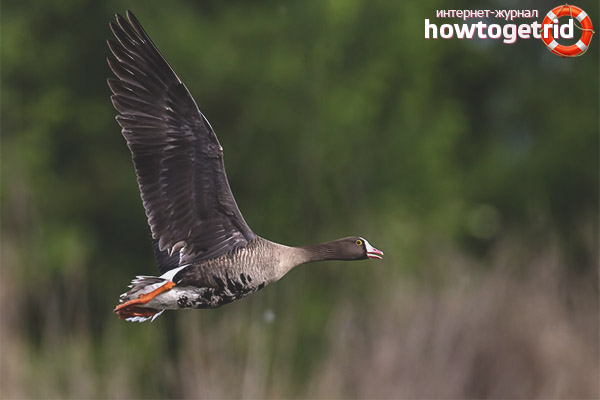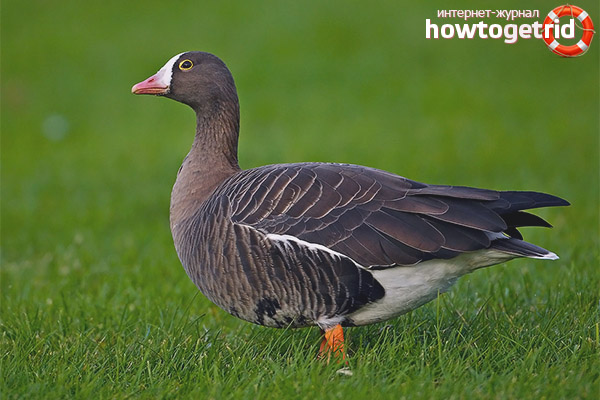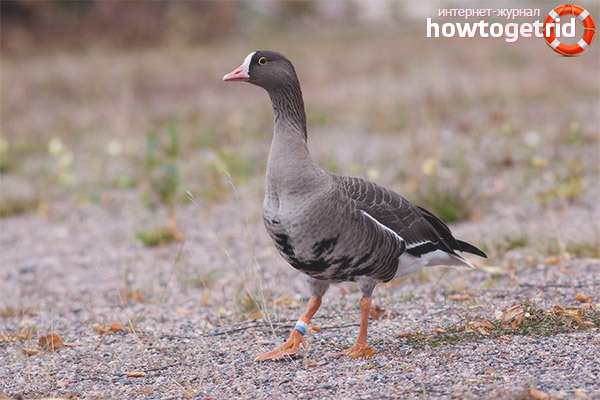The content of the article
In the family of ducks, there is a very rare and practically unexplored goose - a squeak. This is a small bird, which owes its name to a squeak published during the flight, which cannot be compared with anything.
Also, the bird is called a white-breasted goose. And sometimes it is confused with a white-fronted goose, whose exact copy it is. An adult can reach the size of a goose, and the weight of the male is approximately 2.5 kg. At present, the number of prey is significantly reduced, so now this species of birds is listed in the Red Book.
Bird Features and Habitat
The body length of an adult male reaches 65-72 cm, and the wingspan is slightly more than a meter. The average bird weight is about 2-2.4 kg. The plumage color of the pisculi is very reminiscent of ordinary geese, which are bred at home: brownish and gray shades mixed with each other.
A characteristic feature of the goose of the squeak is its dark beak and paws of a yellowish color. By the shade of plumage, there is no way to distinguish between a female and a male. A sign of gender differences is the neck of these geese, which is approximately 35 percent shorter in the female than in the male. The plumage of these birds is lighter from below, and there is much more fluff in the lower part of the body. Outwardly, the squeak is very similar to the white-fronted goose. The difference is only in size - the white carp is often smaller. In addition, there is a yellowish border around the eyes of the pisculka, and a characteristic speck of white is located on the forehead, extending to the very crown.
Most often, pisculata lives on terrain with mountainous or semi-mountainous terrain. Bird nests are located in places near small streams, rivers or small lakes. They feel the maximum comfort in the taiga, forest-tundra terrain or on a landscape with large shrubs, in estuaries and remote places near marshes.
You can meet pisculka in the north of Eurasia, where it borders on the tundra, as well as in Anadyr, on the Kola and Scandinavian postal centers. This species of birds is considered migratory. Piskulku wintering takes place on the Black Sea coast, near the Caspian Sea, in Greece, China, Hungary, Azerbaijan or Romania.
Most often, piskulka erects nests near various reservoirs, but for the nesting itself, a dry plot of land on small hills is necessary. Sometimes the nests of these birds can be seen on the rubble debris or rafts - this is a small dimple lined with a reed stalk or fluff.
Pisculi behavior and her lifestyle
This goose is extremely cautious and suspicious, especially being in its flock. But all the prudence of the bird disappears at the moment when the females monitor the offspring or hatch eggs. In such cases, the squeaky can accidentally let it very close to the nest.
Representatives of this species of birds fly very quickly, but for an outside observer their flight usually seems rather slow. In the process of flying to warmer places, Pisculi fly quite high.
The flight takes place in the form of a V-shaped wedge or an extended wavy line. On the ground, the pisculka moves with a rather firm and strong gait. Also, these birds are able to run quite quickly and quickly.
Often you can notice a pussycat, which stands on one of the legs. Such a goose is a flock of birds, but when they breed, they are with their pair in a separate nesting place.
What do piscules eat
Any birds that are classified as anseriformes can eat both plants and animal products.It is such a diverse diet that allows them to live and develop as fully as possible.
Despite the fact that piskulka loves water procedures and bathing, it is nevertheless referred to as a land-based bird species. In accordance with this, its diet consists mainly of what grows on the earth's surface.
A common pisculi food is green spring grass, which this season is not only rich, but also rich in mineral and vitamin compounds that any animals need after the winter is over.
No less strongly piskulka likes to eat leaves and stalks from young bushes and trees. If a flock of birds lives in a place where fields of various cultures are located nearby, then the pisculata often begins to visit them, preferring to feast on cultivated plants.
Among the many herbs, these geese love wheat, oats, sedge, alfalfa. In the summer, the piskulka does not neglect fruit; it adores mulberry and horsetail. For the most part, this bird eats in the morning and evening, spending the day in the water.
Breeding Pisculi

During the mating season, the male piscule is required to conquer and conquer the female. In the opposite situation, the pair simply will not form. A family arises only after observing all the rules of courtship games.
An adult goose needs various methods to attract the attention of a goose, which he liked. And if the male managed to achieve that the female looked at him, then in this case the pair is finally formed. Goose gives his consent to marriage.
In the future, the male and female begin to arrange the nest, together creating a small hole, which they then cover with moss, fluff and stalks of plants. When the nest is formed, the goose can begin to lay and hatch eggs.
The goose needs about 27 days to hatch. Subsequently, offspring appears, and both parents are engaged in its upbringing. Goose and goose are putting all their strength into saving valuable offspring's life.
In addition, both parents teach them all the necessary knowledge. Chicks grow and develop quite quickly, gaining full independence, the ability to fly and get food, by the age of three months.
A year later, the chicks turn into adults, becoming able to also have offspring. But at the same time, they prefer to be close to their parents. Under natural conditions, pisculi live for about 12 years, and in conditions of home maintenance, the life span can reach 30 years.
Video: pussycat (Anser erythropus)











Submit